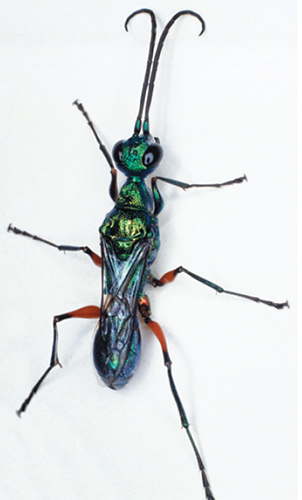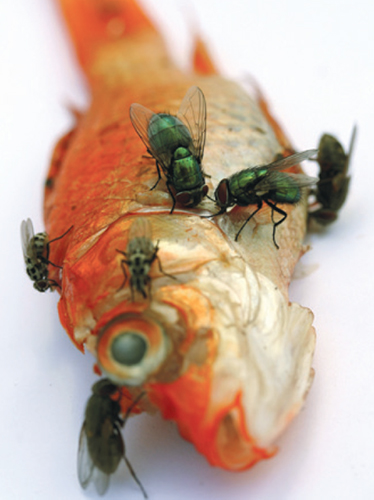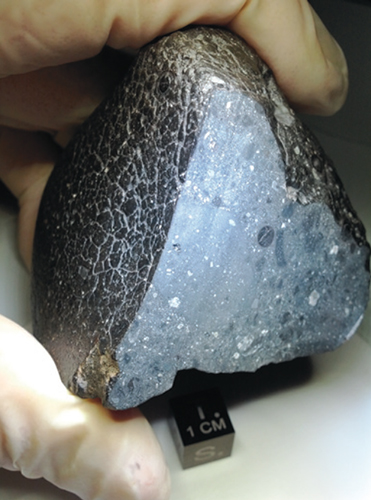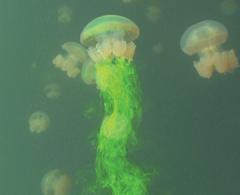
This Article From Issue
March-April 2013
Volume 101, Number 2
Page 113
DOI: 10.1511/2013.101.113
In this roundup, Katie Burke summarizes notable recent items about scientific research, selected from news reports compiled in the free electronic newsletter Sigma Xi SmartBrief.
Cockroach Cleansing
The emerald cockroach wasp Ampulex compressa is a parasitoid, which infects and ultimately kills its host. After its eggs are laid on a cockroach, the larvae develop inside the host, feeding on its internal organs. Cockroaches are notorious vectors of putrefactive or pathogenic microbes, and researchers wondered how the wasp larvae overcome such a nasty set of organisms. They first tested whether American cockroaches (Periplaneta americana) commonly harbor microbes that pose a risk to wasp larvae. The most abundant microbe inhabiting the cockroaches was the bacterium Serratia marcescens, which causes rapid infection and fatality in insects. The team then demonstrated that an oral secretion from the wasp larvae was an effective antimicrobial against S. marcescens. They chemically identified this secretion and showed that it was only present in cockroaches infected with the wasps. Thus, the larvae sanitized their host before devouring it.

Frank Greenaway/Getty
Herzner, G., et al. Larvae of the parasitoid wasp Ampulex compressa sanitize their host, the American cockroach, with a blend of antimicrobials. Proceedings of the National Academy of Sciences of the U.S.A. (Published online January 7)
Memory Back-Up
Previous studies indicated that an enzyme called protein kinase M-ζ (PKM-ζ) was instrumental to long-term memory; inhibiting this enzyme’s activity by injection with zeta inhibitory peptide (ZIP) caused memory loss, and adding the enzyme improved memory. However, the hypothesis that PKM-ζ is necessary for memory has been debunked: Two studies independently showed that transgenic mice lacking a functional copy of the gene that produces PKM-ζ showed normal synaptic performance and had no shortfalls in learning and memory tasks. ZIP inhibited memory even in these so-called knockout mice. These studies led to the conclusion that the effects of ZIP are independent of PKM-ζ and that memory does not depend on the activity of a single crucial enzyme.
Lee, A. M., et al. Prkcz null mice show normal learning and memory. Nature (Published online January 2)
Volk, L. J., J. L. Bachman, R. Johnson, Y. Yu and R. L. Huganir. PKM-ζ is not required for hippocampal synaptic plasticity, learning and memory. Nature (Published online January 2)
Dead Meat Biology
Methods of monitoring wild animals are often not affordable or practical. A past study showed that extracting DNA from leeches’ blood meals could be a cheaper method to identify a region’s mammalian biodiversity. This research served as a springboard for a new study to explore using DNA isolated from carrion flies (families Calliphoridae and Sarcophagidae) for the same purpose, because such flies feed on open wounds or dead animals and are easily collected. Researchers showed that 40 percent of 115 carrion flies caught in Taï National Park of Côte d’Ivoire and Kirindy Forest of Madagascar contained amplifiable mammalian DNA. Leeches and blood-feeding insects such as mosquitoes have feeding preferences that bias samples. But despite a modest sample size, a wide array of mammalian taxa—including rare, elusive species—were identified using DNA from carrion fly meals. The flies therefore are an important source of mammalian DNA for ecological studies.

Emilio Ereza/Getty
Calvignac-Spencer, S., et al. Carrion fly-derived DNA as a tool for comprehensive and cost-effective assessment of mammalian biodiversity. Molecular Ecology (Published online January 8)
New Martian Meteorite
Found in Morocco in 2011, the meteorite dubbed Northwest Africa (NWA) 7034 is unique among the 110 known Martian meteorites collected on Earth. It is similar to basalts from the surface of Mars measured by NASA’s orbiter and lander missions. Although all these meteorites share some geochemical properties that indicate their Martian origin, previously collected meteorites differed in elemental composition from NWA 7034 and from rover samples of rock. For example, NWA 7034 is abundant in the alkali elements potassium and sodium, similar to basalts from the surface of Mars but unlike the other Martian meteorites known to date. NWA 7034 also contained about 10 times greater amounts of extraterrestrial water bound into the rock than did the other meteorites, suggesting that the rock formed at a time when the planet was wetter. And NWA 7034 is about 2 billion years old, much older than most of the other meteorites, which are 200 to 400 million years old. Researchers have proposed that NWA 7034 be classified separately from other known Martian meteorites.

Carl Agee
Agee, C. B., et al. Unique meteorite from early Amazonian Mars: Water-rich basaltic breccia Northwest Africa 7034. Science (Published online January 3)
Absolutely Negative
In the mid-1800s, Lord Kelvin postulated that nothing could be colder than the temperature of absolute zero degrees, when all atomic particles are at rest. But in the mid-20th century, physicists realized that the mathematics governing absolute temperature indicated that subzero temperatures were possible and, soon after that, they were demonstrated. Recently, the first subzero Kelvin temperatures were achieved for particles in motion. Temperature depends on the kinetic and potential energies of atoms and on the interactions between them. By using an optical lattice of laser beams, atoms could still move, but their kinetic and potential energies were held in check. Researchers controlled interactions between the atoms with magnetic fields. This discovery has implications for technology, because negative temperatures could result in more efficient heat engines, and for cosmology, because negative temperatures may explain properties of dark energy.
Braun, S., et al. Negative absolute temperature for motional degrees of freedom. Science 339:52–55 (January 4)

American Scientist Comments and Discussion
To discuss our articles or comment on them, please share them and tag American Scientist on social media platforms. Here are links to our profiles on Twitter, Facebook, and LinkedIn.
If we re-share your post, we will moderate comments/discussion following our comments policy.